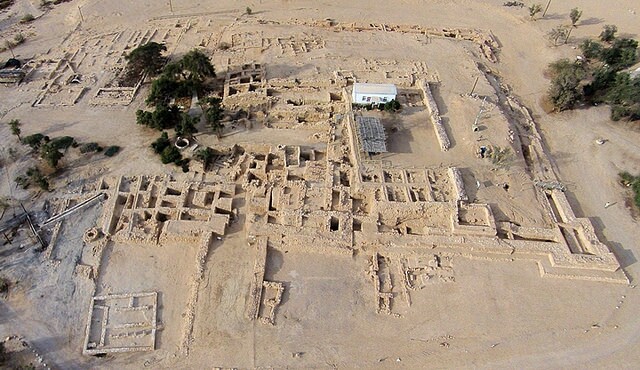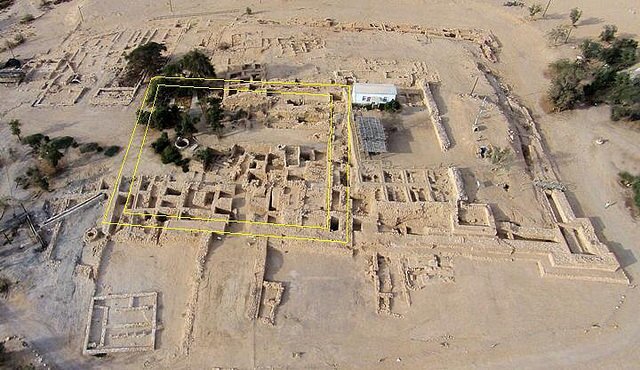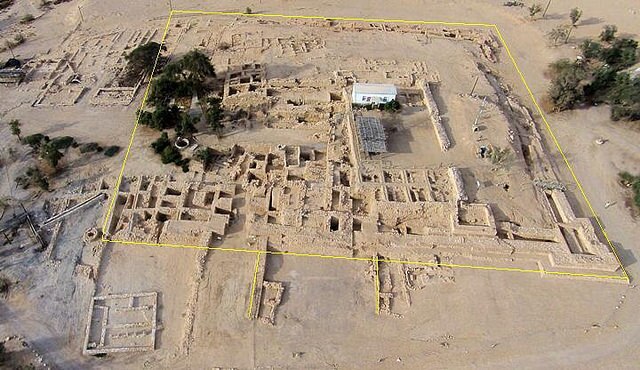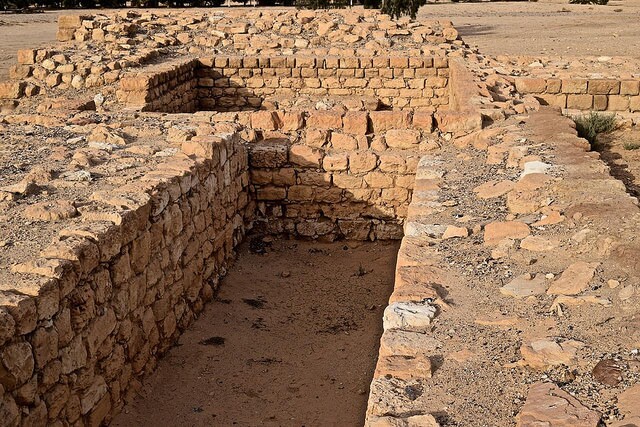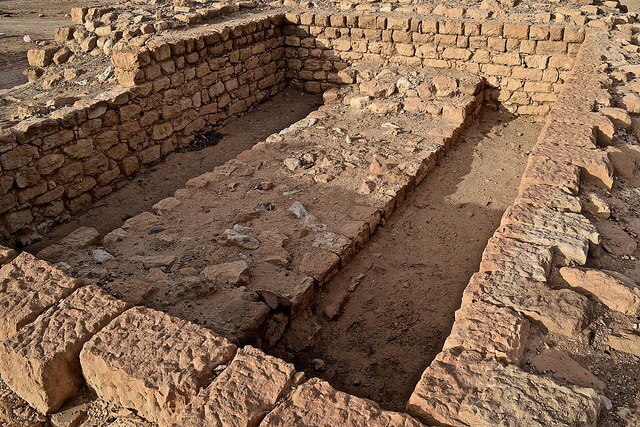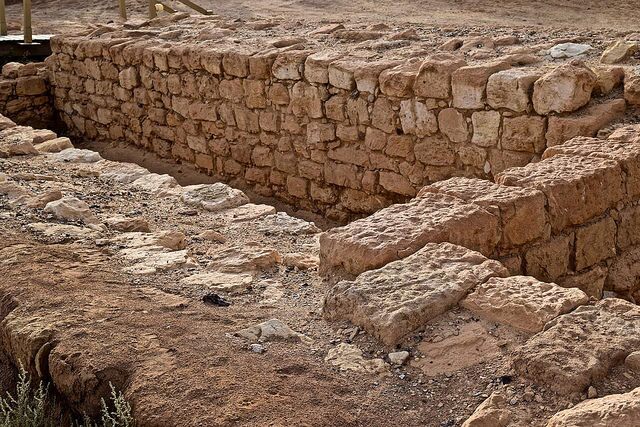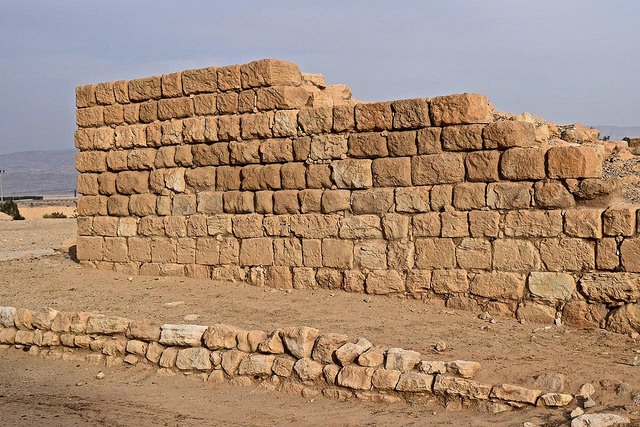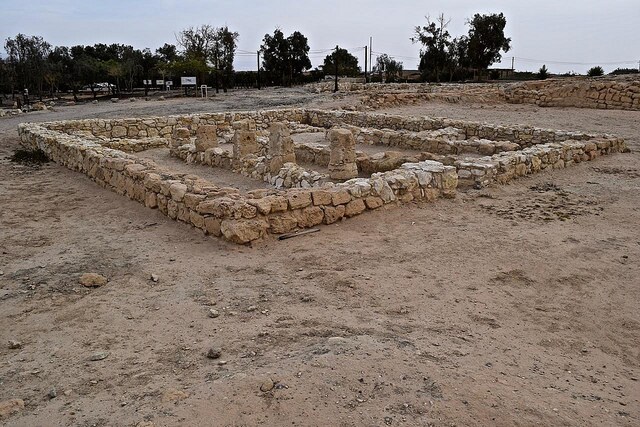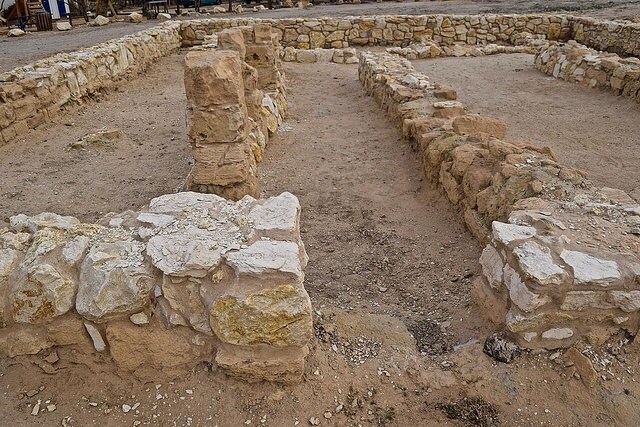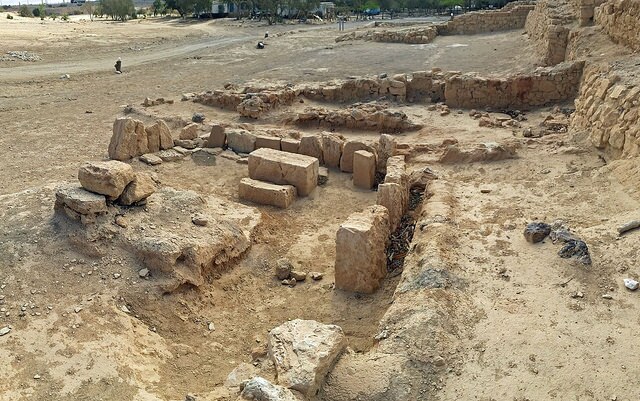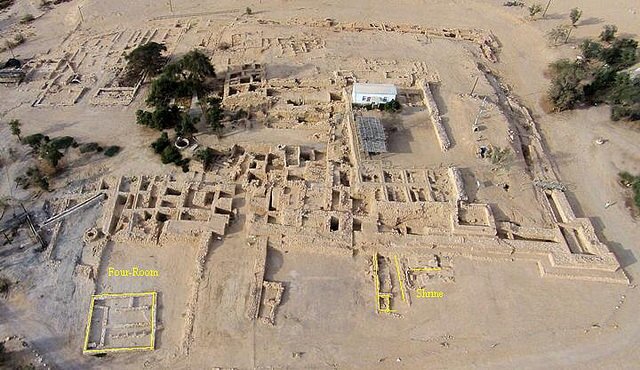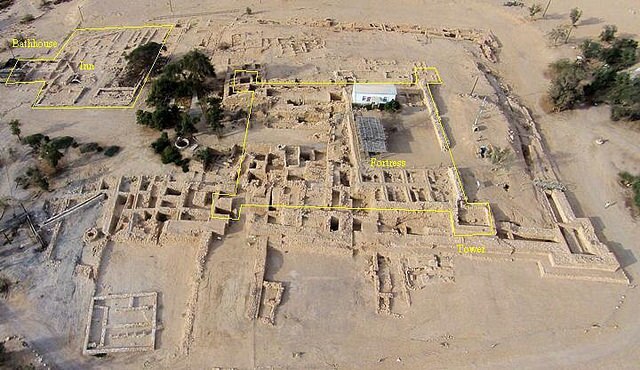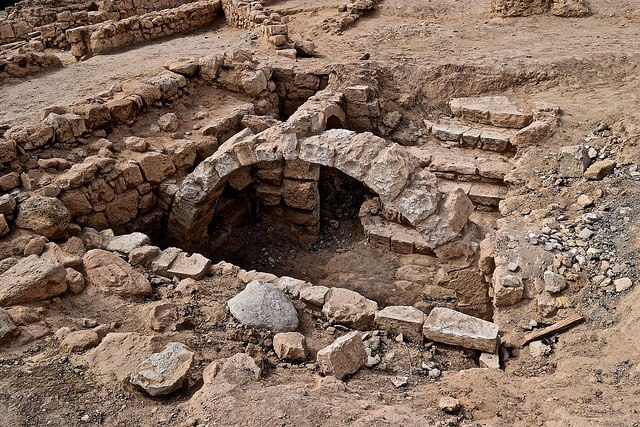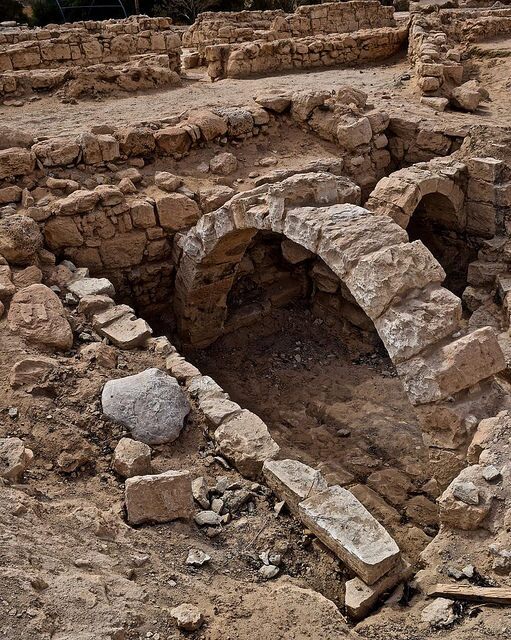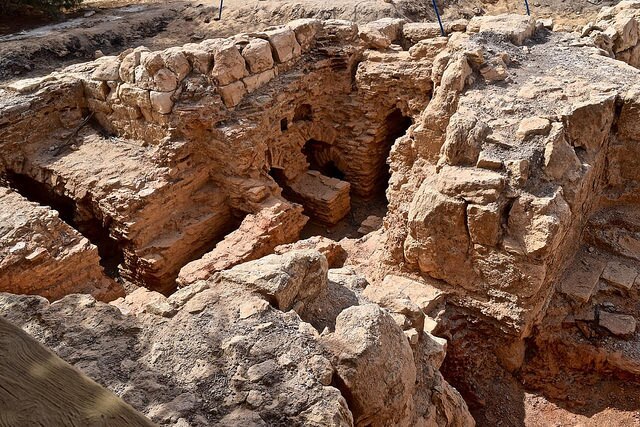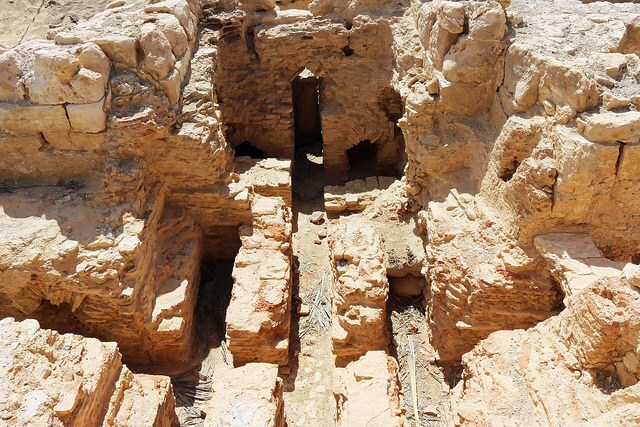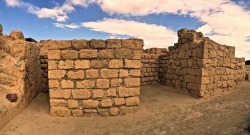
Ein Hatzeva.
In Hebrew, it means “strong spring”.
It also describes the ancient place by this name about 35 kms south of the Dead Sea.
The name says it all, because deep in this desert region, in what the ancients called the Arava, water meant everything. The natural fresh water spring made it a reason for ancient roads to converge here — a critical and welcoming oasis for traveling caravans along the spice and incense route, facilitating commerce and providing much-needed rest for weary travelers. And with this clear strategic value, it became a perfect place for expanding kingdoms to establish their presence.
Fortresses on the Edge
Although the fresh water oasis of Ein Hatzeva has been thought by some to have possibly accommodated ancient Amorites and other wandering, nomadic peoples, it was mostly expanding commerce that transformed this tiny spot into a strategic way station on the fringe of kingdoms. It sat at the intersection of the main Arava road and the Negev-Edom road, a critical stopping point for the traveling caravans of spices and other goods and, at one time, a good location to facilitate oversight and protection of the copper mines at Faynan, near Eilat.
And a good place to build a fort.
Which is why Ein Hatzeva, otherwise known as Biblical Tamar*, has seen the presence of at least five succeeding major fortifications. Archaeological excavations since 1972 have uncovered at least 8 historic periods, revealing a sequence including Early Israelite, Edomite, Nabataean, Roman, Early Arab, and later occupations.
The Israelite and Judahite Fortresses
The earliest of the fortifications was constructed during the 10th century BCE. Comparatively small, some scholars and archaeologists have interpreted these Iron Age remains as one of a number of fortifications constructed throughout the land to secure the border of the united kingdom of Israel under Solomon**. But the most magnificent of the Iron Age fortifications was built somewhat later (archaeologists suggesting its construction during the 9th-8th centuries BCE), atop and around the smaller, older fortress footprint. This fortress, according to Biblical scholars, represented the might of the Kingdom of Judah, although it is not certain who among the Judahite kings was responsible for initiating its construction. Some suggest King Jehoshaphat (867 – 846 BCE), desiring an enlarged fortress as part of his policy to renew and build upon commercial ties with the rich kingdoms of present day southern Arabia to the south and east. Others suggest King Amaziah (798-769 BCE) or Uzziah (769-733 BCE).
In any case, the enlarged fortress is considered to have been among the largest Judahite fortresses ever built, fulfilling a critical role in the Kingdom of Judah’s border defenses. Beginning in the first expansion with a 50 x 50 meter surrounding wall, it was later expanded to 100 x 100 meters, comparable in area to a town of the time. Excavations have uncovered a massive three-meter-thick casemate wall, the casemate sections filled with packed earth. Buttressing the wall was a defensive rampart. Towers were set at its corners. A four-chambered gatethouse complex (a standard feature for cities and fortifications of the period) still stands to a height of three meters in the northeastern corner of the fortress remains. Not intended by its original builders, however, part of the gate complex leans, as if, with one powerful push, one could topple it over. It is a testament to damage caused by a powerful earthquake in the mid-8th century BCE. The fortress remains also feature stores or granaries and silos for food—evidence of wheat and barley found within one of the silos—and a defensive moat.
But as massive and imposing as the 8th century fortress was, the Judahite kingdom eventually lost control of what is today the Negev region, leaving opportunity for expansion by the neighboring Edomites and the fortress’s resulting destruction near the end of the 8th century BCE. A smaller 7th century fortress was built over the remains of the former, but it never attained the grandeur and defensive prowess that characterized the previous larger fortress.
_______________________________________
Aerial view of the excavated remains at Ein Hatzeva. Credit: Biblewalks.com
____________________________________________________
Aerial view of the excavated remains of Ein Hatzeva with excavated area of the first Iron Age (10th century BCE) Israelite fortress highlighted in yellow. Credit: Biblewalks.com
____________________________________________________________
Aerial view of the excavated remains of Ein Hatzeva with excavated area of the first Judahite fortress (9th-8th centuries BCE) highlighted in yellow. Credit: Biblewalks.com
_________________________________________________________________
Aerial view of the excavated remains of Ein Hatzeva with excavated area of the expanded Judahite fortress (9th-8th centuries BCE) highlighted in yellow. Credit: Biblewalks.com
________________________________________________
View of a section of the Iron Age (Israelite) city gate complex remains, one of the grandest discovered in the ‘Holy Land’ region to this day.
_______________________________________________
Above and below, view of a section of the Iron Age (Israelite) city gate complex remains.
______________________________________________________________
Above and below: Views of the remains of the Iron Age expanded fortress northwest wall and tower construction.
________________________________________________
_________________________________________________________________
_________________________________________________________________
__________________________________________________________________
Above: View of the exterior remains of the northwest wall of the expanded Iron Age fortress
————————————————————————
Supplement
The Four-Room House
A key feature uncovered at Ein Hatzeva was a four-room house, built during the period of the Israelite/Judahite fortifications:
____________________________________________
Above and below: The foundation still visible, pictured here are its remains—what archaeologists have identified as a classic Israelite four-room house structure. Most houses inhabited by the Israelites during the Iron Age, beginning at the end of the 11th century BCE until about the time of the Babylonian Exile in the 6th century BCE, were designed after this floor plan pattern. It characterized the ground floor of the house, as this is the house level that could be determined through archaeological investigation. It typically featured four sections, or rooms, three of which were defined by two rows of wooden pillars arrayed through the center of the structure and functioning to divide the spaces, and the fourth ‘broadroom’ oriented across the back or rear of the three vertical rooms. This ground level typically functioned as space to stable livestock and for storage. The family, or extended family, resided on the upper level. Like any domicile even today, these houses varied in size, and were constructed either as stand-alone houses or as connected houses (ancient equivalent of the modern day townhouse). Many connected houses were constructed with the back, or broadroom, exterior wall abutting the surrounding casemate wall of a city. Walls, constructed of fieldstones and dried mud, were typically around one meter in thickness, with exterior walls often thicker. The house exteriors were likely plastered to prevent water erosion. Archaeological investigation has revealed that smaller urban houses may have been clustered, sharing exterior walls between and likely inhabited by nuclear families, whereas larger stand-alone houses, like the one illustrated here at Ein Hatzeva, belonged to wealthy or extended families of the elite. “This is the biggest Israelite house in Israel,” says Dr. DeWayne Coxon of the house at Ein Hatzeva. “It was probably the priest’s house.” Coxon is President of Blossoming Rose, the organization that curates the archaeological site at Ein Hatzeva.
Along with the Israelite and Roman fortresses, bathhouse, and the Edomite cultic shrine, the large Israelite four-room house stands as one of the distinguishing features of the archaeological park, known as the Biblical Tamar Park, administered by Blossoming Rose on behalf of the Israel Antiquities Authority.
————————————————————————
Supplement
The Shrine
During the 7th century BCE, just north of the fortress ruins, the Edomites built a temple or cultic shrine, likely functioning to serve traders journeying from Edom to the Negev region. Excavations have revealed the foundational outlines of the structure, as well as an assemblage of broken ritual clay vessels and evidence of several stone altars, discovered in a repository within the structure. The finds include bowl-shaped incense stands on round bases, one of them featuring small clay objects in the shape of pomegranates (considered symbols of fertility), originally hanging from hooks; and anthropomorphic stands featuring human figures with decorated bowls atop their heads.
Archaeologists and historians suggest that the shrine was probably destroyed and the ritual objects smashed during the reign of the Judahite king Josiah, who embarked on a campaign of religious reforms at the end of the 7th century BCE. The Biblical account (2 Kings 22-23) records this campaign of destruction. The shrine remains and the ritual vessels found at the site are currently exhibited at the Israel Museum in Jerusalem.
____________________________________________
Above and below: Two views of the shrine remains. Above photo courtesy Victoria Brogdon.
——————————————————————–
Aerial view of the site remains, highlighting the locations of the four-room house and shrine in relation to the ancient fortress remains. Credit: Biblewalks.com
______________________________________________________
The Nabataean Fortress
Archaeologists unearthed evidence of a small Nabataean (1st century BCE – 1st century CE) fortress and temple beneath the remains of the later Roman fortress (described below). Investigators believe these structures were constructed here as part of a way station the Nabataeans established as a rest and commercial stop along their Incense road.
The Romans
Ancient Rome’s expanding empire from the 1st century BCE through the 4th century CE saw its presence in almost every corner of the known Western world, and the attractive desert oasis of Ein Hatzeva was no exception. Because of its location along the lucrative caravan routes for transport and trade in spice and merchandise, not to mention its position relative to controlling and protecting the critical Faynan copper mines to the southeast near present-day Eilat and territorial defense against the incursion of outside nomadic tribes, the Romans quickly recognized the imperative of establishing a strategic foothold here. A large Roman fortress took shape over its gentle rise of earth and ruins, and soldiers were garrisoned here in a new fortification, the architectural remains of which have been unearthed by teams of archaeologists in recent years. Part of the massive Roman fortress has been exposed and partially restored by experts and volunteers, including a significant associated bathhouse complex.
_________________________________________
Aerial view showing highlighted Roman fortifications and structures. Credit: Biblewalks.com
_________________________________________________
Above and below: Excavated sections of the Roman period bathouse remains.
Above photo by Victoria Brogdon
______________________________________________________
The Biblical Tamar Park
For decades, Blossoming Rose, the organization established to administer the site of Ein Hatzeva as an archaeological park, has governed the planning and execution of activities related to the park on behalf of the Israel Antiquities Authority. Today, the site hosts volunteer groups for continuing site restoration and excavation, as well as tour groups organized by various organizations and tour leaders in the country visiting the biblically historic sites throughout the ‘Holy Land’ region. Many visitors, by arrangement, stay in rustic but comfortable accommodations while performing volunteer or other activities at the site.
Although Ein Hatzeva, or Biblical Tamar, is off the beaten path for most typical tour groups and visitors to this historic region of the world, the site administrators and archaeologists hope that the significance of the site will continue to rise on the ‘radar screens’ of the general public and those visiting the region. Certainly the site’s finds, both monumental and small, have played an important role in helping archaeologists and historians to better understand the history and culture of the region. Indeed, according to Coxon, there are 26,000 artifacts from this site alone in the Israel Museum, one of the nation of Israel’s most visited destinations and arguably one of the world’s preeminent archaeologic museums.
There is much more work to be done at Ein Hatzeva before the full story of its remains can be realized. With funding and a greater commitment of resources, however, the site can prospectively yield much more, including the possibility of uncovering remains from time periods pre-dating the Iron Age, or Israelite, period. More information about the site and the park can be obtained at blossomingrose.org.
______________________________________________________
*The archaeological remains were surveyed near the start of the 20th century and then excavations between 1987 and 1995 confirmed its identification with Biblical Tamar: Ezekiel 48:28 —“The border shall be even from Tamar by the waters of strife in Kadesh (Ezekiel 48:28) and as the Roman Tamara.”
** 1 Kings 9: 17-18: “And Solomon built Gezer, and Beth-horon the nether, and Baalath, and Tadmor [Tamar] in the wilderness, in the land……”
Cover image, top left: View of the Iron Age gate complex at Ein Hatzeva. Image credit: Victoria Brogdon
______________________________________________________
Become a new Popular Archaeology premium subscriber for only $9.00 a year.
___________________________________________
Travel and learn with Far Horizons.
____________________________________________

